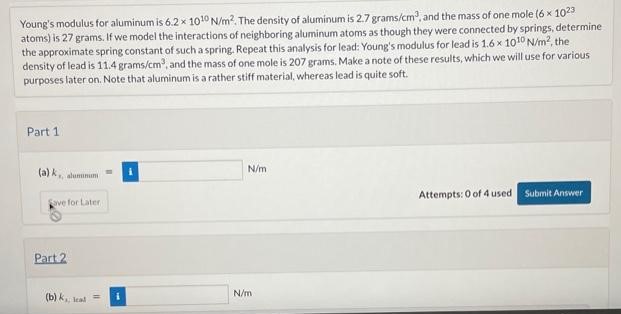QQuestionAnatomy and Physiology
QuestionAnatomy and Physiology
Young's modulus for aluminum is $6.2 \times 10^{10} \mathrm{~N} / \mathrm{m}^{2}$. The density of aluminum is 2.7 grams $/ \mathrm{cm}^{3}$, and the mass of one mole ( $6 \times 10^{23}$ atoms) is 27 grams. If we model the interactions of neighboring aluminum atoms as though they were connected by springs, determine the approximate spring constant of such a spring. Repeat this analysis for lead. Young's modulus for lead is $1.6 \times 10^{10} \mathrm{~N} / \mathrm{m}^{2}$, the density of lead is 11.4 grams $/ \mathrm{cm}^{3}$, and the mass of one mole is 207 grams. Make a note of these results, which we will use for various purposes later on. Note that aluminum is a rather stiff material, whereas lead is quite soft.
# Part 1
(a) $k_{s, \text { aluminum }}= 1 \quad \mathrm{~N} / \mathrm{m}$
See for Later
Attempts: 0 of 4 used
Submit Answer
## Part 2
(b) $k_{s, \text { lead }}= 1 \quad \mathrm{~N} / \mathrm{m}$
Attachments

6 months agoReport content
Answer
Full Solution Locked
Sign in to view the complete step-by-step solution and unlock all study resources.
Step 1: Understand the problem and gather necessary information.
where $Y$ is Young's modulus, $A$ is the cross-sectional area of the spring, and $d$ is the distance between atoms (assumed to be the same for both aluminum and lead).
We are given the Young's modulus for aluminum and lead, as well as their densities and atomic masses. We are asked to find the approximate spring constant of a spring that models the interactions between aluminum and lead atoms, assuming they behave like connected springs. We can use the following formula to find the spring constant:
Step 2: Convert the given densities to SI units (kg/m$^1$).
Lead density: $11.4 \, \mathrm{g/cm}^3 \times \frac{1000 \, \mathrm{g}}{1 \, \mathrm{kg}} \times \frac{1 \, \mathrm{m}^3}{10^6 \, \mathrm{cm}^3} = 1.14 \times 10^4 \, \mathrm{kg/m}^3$
Final Answer
(a) The approximate spring constant for aluminum is $3.39 \times 10^9 \, \mathrm{N/m}$. (b) The approximate spring constant for lead is $6.88 \times 10^7 \, \mathrm{N/m}$.
Need Help with Homework?
Stuck on a difficult problem? We've got you covered:
- Post your question or upload an image
- Get instant step-by-step solutions
- Learn from our AI and community of students